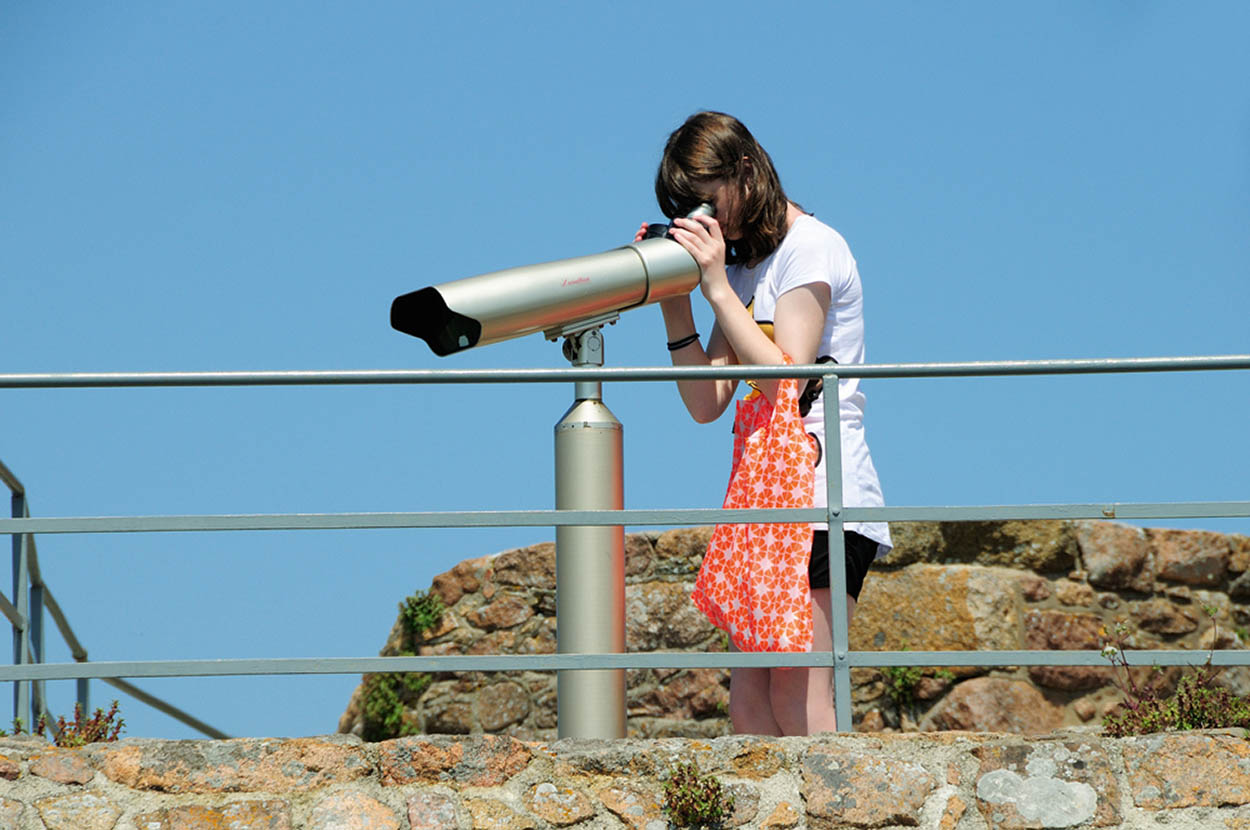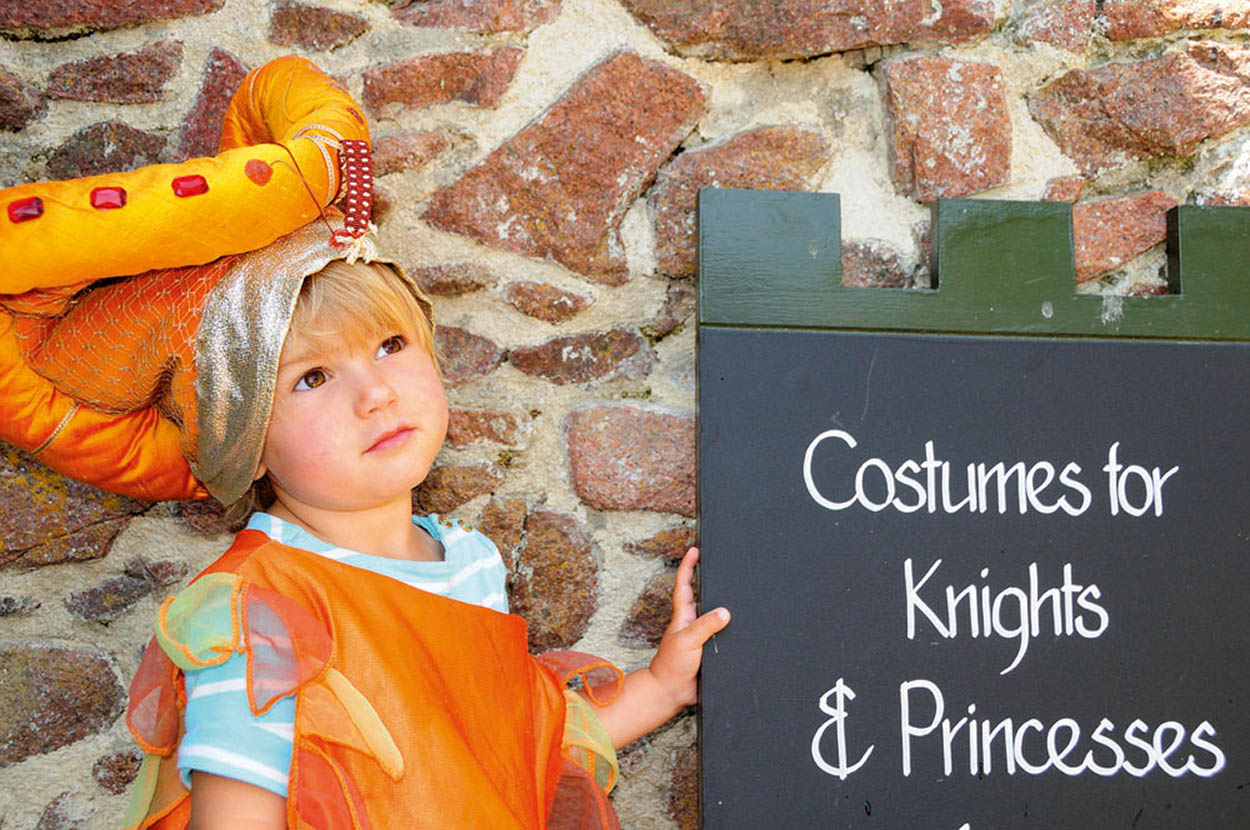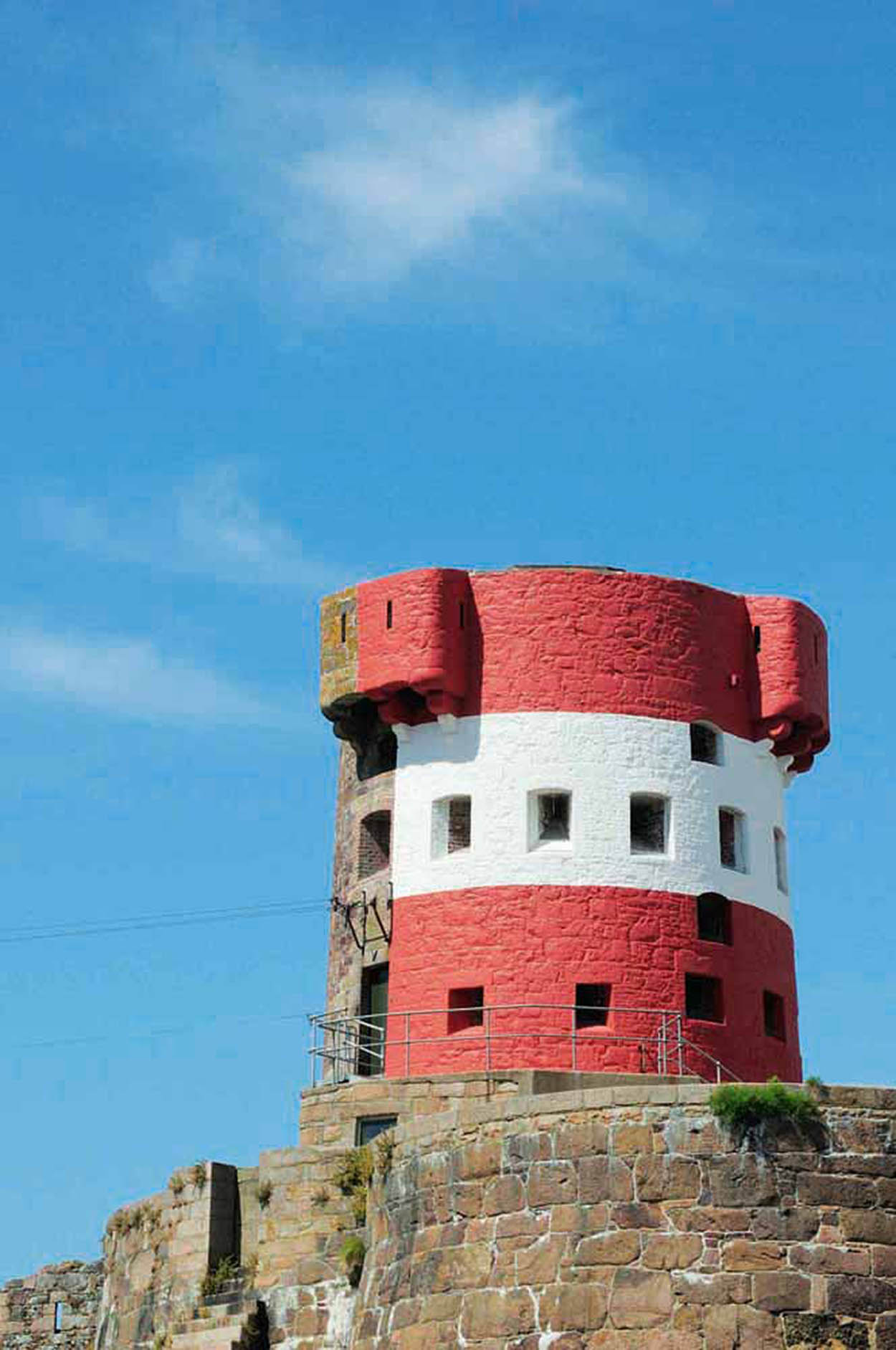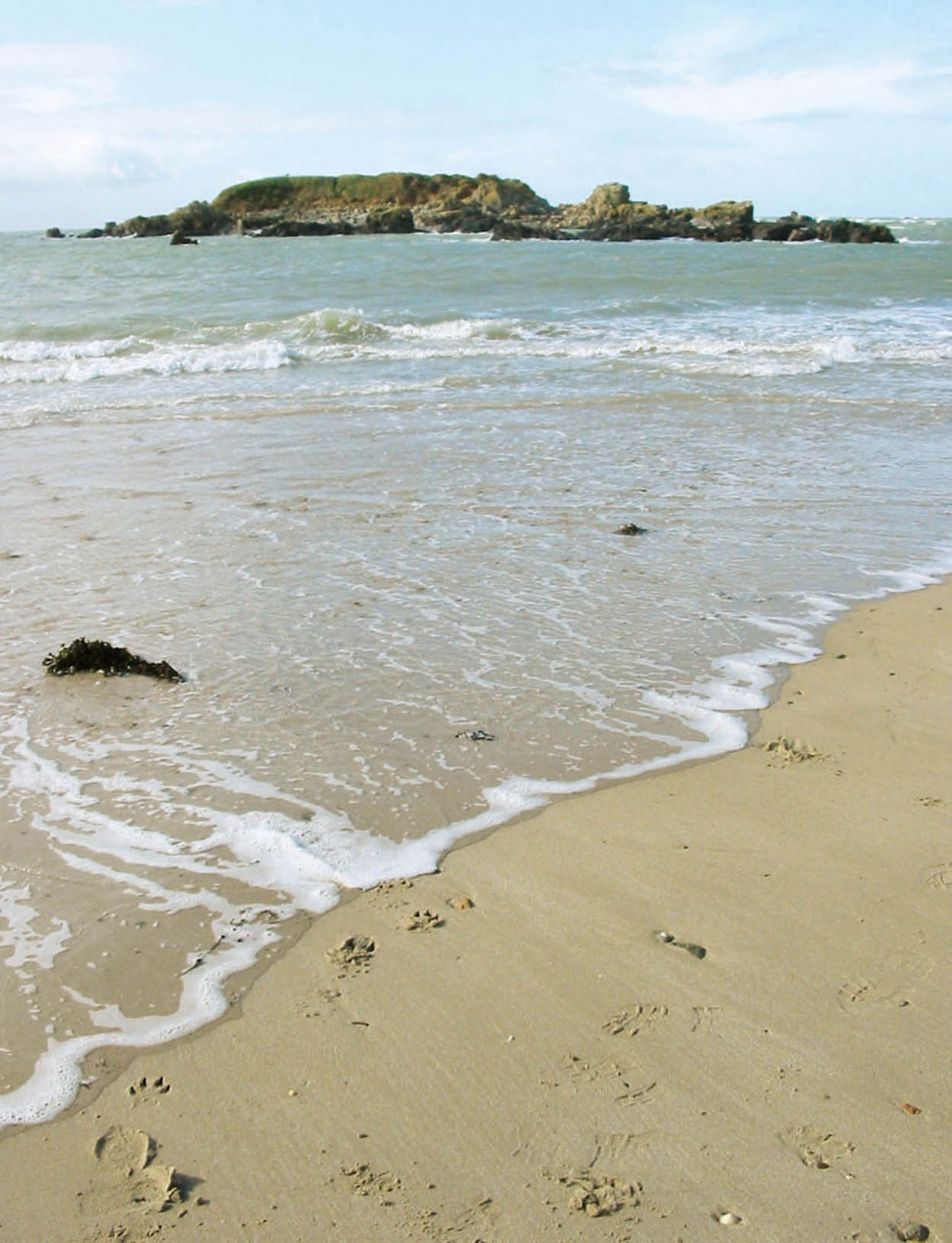
Mont Orgueil, Jersey’s oldest castle.
Mockford & Bonetti/Apa Publications
Tour 6: Sights of the East
History, gastronomy, gardens and beaches – the southeast has it all, and this exciting 18-mile (30km) whole-day driving or cycling tour caters for all tastes.

Mont Orgueil, Jersey’s oldest castle.
Mockford & Bonetti/Apa Publications
Mont Orgeuil Castle, set spectacularly above Gorey harbour and commanding the entire east coast, is the most photographed landmark on the island. The medieval fortress played a major role in Jersey’s tempestuous history, repulsing repeated French invasions from 1204–1600. The quaint harbour below Mont Orgueil Castle and the spacious sands of the Royal Bay of Grouville provide a pleasant break from sightseeing, while the gardens of Samarès Manor are the highlight of the return trip to town.
A legacy of more ancient history is La Hougue Bie, a finely preserved Neolithic passage grave, its mound a dominant feature of the landscape for 6,000 years.
Take the St Helier ring road, following signs first for the north and then for the A7 to the Five Oaks roundabout. This will take you through the parish of St Saviour, where actress Lillie Langtry, was born. She was married twice in the Church of St Saviour, and is buried in the churchyard here. Government House, south of the church, is the official residence of the Lieutenant-Governor, the Queen’s representative on the island.
La Hougue Bie
At the Five Oaks roundabout, turn right on to Princes Tower Road (the B28). From here follow the signs for La Hougue Bie 1 [map] (www.jerseyheritage.org). This remarkable site, in the heart of the countryside, is dominated by a burial mound, covering a Neolithic passage grave, dating from about 3500 BC. The word “Hougue” derives from the Norse haugre, meaning a burial mound, and the “Bie” was probably a corruption of the Norman family name of Hambye. The site can be a bit confusing, and it’s worth watching the short film presentation near the entrance before you start your visit.
This intriguing site abounds with legends, and notably the tales of the dragon which lived in the marshes of St Lawrence and terrified the islanders. Hearing of their plight, the gallant Seigneur of Hambye came from his castle in Normandy and slew the dragon. After the long battle he fell asleep and his squire, who had designs on his master’s wife, murdered him and buried the body.
The squire returned to Hambye, leading the wife to believe that the dragon had killed her husband and he (the squire) had gallantly slain the dragon. The Seigneur’s dying wish, he told her, was for his wife to marry the servant who had avenged his death. She agreed to marry the squire but the new Lord Hambye soon disclosed his guilt in his sleep. On discovering the truth Lady Hambye came to Jersey and buried her husband under a mound (La Hougue Bie) on the site of his grave. She ordered the mound to be built so high she could spy it from her castle keep in France. The mound was named La Hougue Hambye.
Sights of the East


La Hougue Bie is one of the largest and best-preserved passage graves in Europe and dates back to 3500 BC.
Mockford & Bonetti/Apa Publications
History of La Hougue Bie
Excavations under the mound in 1924 revealed a low passage leading to chambers made of huge stone blocks. The mound is 40ft (12 metres) high and covers a chamber that is 33ft (10 metres) long. The larger stone slabs may have been dragged from a distance of 4 miles (6km), possibly on sledges or rollers. Fragments of bone from eight bodies, along with flint tools, bones of sheep, pig and ox, beads and pottery were all discovered within the dolmen. Limpet shells were also found here, proving that way back in prehistoric times the farmers were enjoying Jersey seafood.
The old pagan site had been Christianised by the construction of two medieval chapels on top of the mound. The first was Notre Dame de la Clarté, dating from the twelfth century, but heavily restored. Four centuries later the local dean rebuilt its chancel, which became known as the Jerusalem Chapel. During the Reformation the chapels were abandoned, but in the late 18th century were transformed by Philippe d’Auvergne, Duke of Bouillon, a scholar and eminent sea captain. Straddling the two chapels he built The Prince’s Tower (La Tour d’Auvergne as it was known), a neo-Gothic folly which became one of the most distinctive and dramatic landmarks of the island. In the early nineteenth century the tower became one of Jersey’s first tourist attractions, offering panoramic views. In the late 1830s it was extended to create the Prince’s Tower Hotel, which became popular for eating, drinking and dancing. But by the late nineteenth century the tower was derelict. A restoration committee in 1924 decided – against the wishes of most of the islanders – that the Prince’s Tower be demolished so that the medieval chapels could be restored to their original form.

Inside the chapel of Notre Dame de la Clarté at La Hougue Bie.
Mockford & Bonetti/Apa Publications

Inside the geology and archaeology museum at La Hougue Bie are fine examples of flint tools found at La Cotte de St Brelade.
Mockford & Bonetti/Apa Publications
Dean Mabon’s Miracles
Richard Mabon, Dean of Jersey from 1509, built a small oratory under the Jerusalem Chapel, which was inspired by his pilgrimage to the Holy Sepulchre in Jerusalem. Mabon claimed to receive visions of the Virgin Mary while he was praying in the crypt and organised for pilgrims to visit the site. According to a Protestant chronicler, the Dean used to fake miracles here, making money from gullible pilgrims.

Two chapels under one roof at La Hougue Bie.
Mockford & Bonetti/Apa Publications
Visiting La Hougue Bie
To access the burial chamber below the mound you have to stoop right down and walk along the dark, tunnel-like passage grave. The mysterious chamber, together with the side chambers, is likely to have served not only for burials but as a ritual and ceremonial site (not that there’s much space for festivities). From the bottom of the mound a spiral path winds up to the chapels on the top. Switch on the lights in the Jerusalem Chapel to see the traces of two archangels on the wall.
At ground level you can visit the geology and archaeology museum, which displays bones and teeth of prehistoric animals discovered at La Cotte de St Brelade. A legacy of more recent history is the German command bunker at the foot of the mound, housing a poignant exhibition dedicated to slave workers in the Channel Islands. The Germans also constructed a watchtower on top of the mound at the west end (no longer extant) and seventy trenches within the grounds.

Jersey coat of arms at Mont Orgueil Castle.
Mockford & Bonetti/Apa Publications
Mont Orgueil Castle
Turn right out of La Hougue Bie and follow the signs for Gorey on the east coast. Nearing the village, a steep road brings you down to that most famous of Jersey landmarks, Mont Orgueil Castle 2 [map] (www.jerseyheritage.org). Translated as Mount Pride, and also known as Gorey Castle, this mighty fortress towers over the harbour and commands spectacular views. A fine example of a concentric castle, it was sited on an Iron Age hill fort and designed with a series of independent defences, with walls going straight out of the rock.

Built on the site of an Iron Age hill fort, Mont Orgueil Castle stood up to several full-scale attacks between the 13th and 15th centuries.
Mockford & Bonetti/Apa Publications

Taking in the views from the castle battlements.
Mockford & Bonetti/Apa Publications
The castle is an impressive site at any time of day, but it is particularly picturesque after dark in summer when the battlements are floodlit.
Impregnable fortress
From 1204, when King John lost the English territories in France and the Channel Islands elected to remain loyal to the English crown, hostilities prevailed between the islands and France. Jersey was frequently threatened by invasions, and fortifications were constructed, particularly along the vulnerable east coast, lying just 14 miles (22km) from Normandy.
Mont Orgueil was built on a promontory overlooking the French coast and remained the main stronghold on the island for nearly four centuries. The great medieval fortress withstood many attacks from the French, including a devastating raid in 1373 by the Constable of France, Bertrand du Guesclin, otherwise known as the Black Dog of Brittany. During its long history, the castle fell just once, in 1461, and a French force captured and held the island for the next seven years. Although the castle had been adapted to accommodate cannon, and later transformed into an artillery fortress, it could not keep up with the demands of modern-day warfare.
Somerset Tower
A climb up the steep castle battlements to Somerset Tower will reward you with a jaw-dropping panorama. You can see why the Germans adapted the tower as an observation post in World War II. France can usually be seen across the water, and on a really clear day you can make out the power station at Cap de la Hague on the tip of the Cherbourg peninsula.

Detail of an equestrian statue in the castle grounds.
Mockford & Bonetti/Apa Publications

Children can raid the dressing-up box at Mont Orgueil Castle, and spend their visit transformed into a medieval queen or a knight in shining armour.
Mockford & Bonetti/Apa Publications
In the late sixteenth century the decision was taken to build a new fortress, Elizabeth Castle, in St Aubin’s Bay. Mont Orgueil became redundant and known as Le Vieux Château. Were it not for the intervention of Sir Walter Raleigh, who thought it a shame to lose such a “stately fort”, the castle would have been razed to the ground.
In the 17th and 18th centuries the castle played various roles: a stronghold of the Royalists in the English Civil War, a state prison under Cromwell, an island prison for those identified as witches, a refuge for French aristocrats and the headquarters of a spy network during the French Revolution. You can still see the chamber where William Prynne, the seventeenth-century puritan, began his sentence. Not only incarcerated, he had his ears cut off and the initials S.L. (Seditious Libeller) branded upon his cheek. In 1907 the castle was given to the people of Jersey by the crown for use as a historic monument and visitor attraction. In 1940 the Germans fortified the site with observation towers, trenches and gun emplacements, and the keep was used as a barracks.

Birds are trained using techniques dating from the Middle Ages.
Dreamstime
Living History
May to October a series of events from Jersey Heritage bring to life the island’s history through costumed interpretations, set against the backdrop of historic sites. At Mont Orgueil Castle see medieval swordsmen practising their skills, or perhaps enjoy music and juggling performed by the court jesters, or watch a demonstration of medieval falconry. See www.jerseyheritage.org for a list of what’s on.

One of many sculptures inside the castle.
Mockford & Bonetti/Apa Publications
Climbing the ramparts
It’s a long haul to the top, via cobbled passages, paths and some two hundred steps, with fine views all the way. En route you can explore towers, batteries, cellars, chapels, medieval halls – and more. A series of stand-alone exhibits are scattered throughout the castle, all providing a flavour of the medieval era and Jersey’s role within it. These are mostly sculptures, many of them very striking, ranging from replica Tudor artillery pieces and life-size figures manning the ramparts to witches and warriors, a urine wheel (used by medieval physicians to diagnose patients by the colour of their urine) and the gory Wound Man, pierced by spears and daggers. Keeping history alive, there are experts demonstrating Tudor hawking and military weapons, medieval singers, a room of dressing up clothes and wooden soldiers with bows and arrows at the ready.
Gorey Harbour
In the shadow of the castle lies the quaint harbour of Gorey 3 [map] , where shops, pubs and cafés cluster around the waterfront. The quayside offers plenty of places to stop for a bite, among them Feast.
The original village expanded in the late eighteenth and early nineteenth centuries when the flourishing oyster industry gave Gorey the sobriquet of “the pearl of the east”. Oysters were discovered on the muddy seabed between Jersey and Normandy in 1797. The catches were exported to England in large quantities and the trade flourished. Following the decline of the oyster fishing trade at Whitstable, hundreds of English oyster fishermen invaded the coast to share in the profits. By the 1830s the village had doubled in size; there were two hundred and fifty oyster fishing ships, bringing in around 12,000 oysters on each trip. By the middle of the century the oyster beds had been over-fished and the industry was all but over. You can still find a few oysters on the rocks, but those on your plate will have been nurtured in farms in Grouville Bay, where over four million oysters are now produced annually.

A view of the castle gardens and Gorey harbour.
Mockford & Bonetti/Apa Publications

Jersey oysters are cultivated on the rugged east coast near La Rocque.
Mockford & Bonetti/Apa Publications
Gorey harbour today protects a fleet of pleasure craft and is the only official seaport in Jersey apart from St Helier, however the high-speed catamaran trips to the port of Carteret in Normandy now run from St Helier.
St Helier to Paris
By 1881 you could buy a through ticket all the way from St Helier to Paris. You travelled with the Jersey Eastern Railway Company to Gorey station, by horse and cart to Gorey pier, then a steamer across to Carteret and from here on the new railway line to Paris. However, the company suffered competition from buses, introduced in Jersey in the 1920s, and in 1929 it went into liquidation.
St Catherine’s Bay
From Gorey, follow the coastal B29 north. The road skirts the pebble and sandy bay of Anne Port, and follows the coast by the bay of Havre de Fer and past the distinctive red-and-white Archirondel Tower, built in 1874. The tower has recently been restored and can now be hired for basic holiday lets through Jersey Heritage. Keep to the B29 for St Catherine’s Bay 4 [map] , enclosed to the north by a 0.6-mile (1km) -long breakwater which was built as a result of a British blunder in the mid-nineteenth century.
In answer to a naval base at Cherbourg and other French coastal installations, the British Government chose this site (as well as one at Alderney) for a harbour. Despite warnings that the depth of water was insufficient and the harbour would silt up, the project nevertheless went ahead and a breakwater was built here, with another one started at Archirondel. Twenty years and £250,000 later, the project was abandoned. The St Catherine’s arm of the harbour was preserved and a lighthouse built at the end.

The Archirondel Tower at St Catherine’s Bay.
Mockford & Bonetti/Apa Publications
Today the breakwater is a popular spot for fishing and promenading, and the Breakwater Café offers good views from its outdoor tables.
Just south of the breakwater is a German bunker, which for several years until recently housed a turbot farm.
The coast road stops at this northern end of St Catherine’s Bay, but you can get to Fliquet Bay to the north on foot.
Geoffrey’s Leap
North of Gorey the coast road climbs up towards the rocky promontory known as Le Saut Geoffroi or Geoffrey’s Leap, named after a convicted criminal and renowned womaniser who managed to survive unscathed after his punishment of jumping from the cliffs to the rocks below. He was declared a freed man but, eager to impress the fair sex, he decided to perform the feat again. This time, however, his luck ran out.
Royal Bay of Grouville
East of Gorey Village, the Royal Bay of Grouville 5 [map] stretches for 3 miles (5km) between Gorey and La Rocque Point. Guarding the bay are a number of towers built as coastal defences in the second half of the eighteenth century. These fortifications were armed and manned, but never actually used to defend the island. Some of them have now been converted to private residences. Queen Victoria, so impressed by this long and spacious sandy bay, gave it the Royal prefix after her visit in 1859. Today the beach is popular with sunbathers and water sports enthusiasts. As you go south you’ll see the links of the Royal Jersey Golf Club, the most exclusive on the island. Harry Vardon, six times British Open Championship winner, was born in Grouville.

Beach fun on the Royal Bay of Grouville.
Mockford & Bonetti/Apa Publications
Moon Walk
For a unique experience take a “moonwalk” on the seabed to Seymour Tower. Through guided walks organised by Jersey Walk Adventures (www.jerseywalkadventures.co.uk) you can explore the savage low-tide seascape of gutters, reefs, tidal flats, lagoons, sandbanks and boulder fields – said to resemble the surface of the moon. During night walks the tiny creatures in the water and the seaweed glow in the dark like fireflies or glow worms. Prepare to get your feet wet!

Enjoy a hike across the lunar seascape.
Mockford & Bonetti/Apa Publications
Seymour Tower
The route returns to St Helier via the coast road, the A4, stopping at the little harbour of La Rocque 6 [map] on the southeastern tip of the island. It was here that Baron de Rullecourt and his troops secretly landed in January 1781, en route to their defeat at Royal Square in St Helier. Low tide reveals a vast lunar landscape of reefs, gullies and rock pools. Seymour Tower, standing on a rocky islet 2 miles (3km) to the southeast, has stood guard over the island since 1782. It can be reached on foot, but beware of the large tidal flow and the rapid incoming waters: the sea can rise 18ins (50cm) in 10 minutes. (Check the times of the tides in the Jersey Post or at https://www.gov.je/weather/tidetimes). For the adventurous there is the opportunity of staying at the tower overnight (it sleeps 7). Access is restricted to specific days, dependent on the tides, and all groups must be accompanied by an accredited guide (for further information visit www.jerseyheritage.org).

The isolated Seymour Tower was built as part of Jersey’s coastal defence and dates back to the 18th century.
Mockford & Bonetti/Apa Publications

A statue of Harry Vardon, six times Open golf champion, takes a swing at the Royal Jersey Golf Club.
Mockford & Bonetti/Apa Publications

Green Island is only an island at high tide.
Public domain
Green Island
From La Rocque continue on the A4, detouring briefly after 2.5 miles (4km) at Green Island 7 [map] , a few hundred metres off the coast and the most southerly in the British Isles. A small rocky outcrop covered in grass (hence the name), it is only an island when the tide is high and is otherwise accessible by foot. Prehistoric graves, along with human and animal bones, were discovered here in 1911, but were removed for safekeeping to the Jersey Museum in St Helier. The island has gradually been eroded by the sea, and restorers are currently trying to prevent it from being washed away.

Samarès Manor is an elegant house set in extensive grounds incorporating ornamental gardens and ponds with swans.
Mockford & Bonetti/Apa Publications
The main attraction here is the Green Island Restaurant, perched at the top of the slope and offering amazing views from the terrace, which is the perfect suntrap in summer.

The Herb Garden at Samarès has a unique collection of culinary and medicinal plants.
Mockford & Bonetti/Apa Publications
Ramsar Site
This southeastern corner of Jersey, equating to 25 percent of the island’s landmass, is designated as a Ramsar Site (Wetland of International Importance), one of four on Jersey. The low-lying south and southeast coast are also prime areas for ornithologists. The vast expanse of mud, sand and rocky outcrops provides a rich breeding ground for thousands of wintering waders, gulls and wildfowl. Plovers, redshank, turnstone, dunlin, bar-tailed godwits, curlew and oystercatchers can be seen on an incoming tide along the rocky shore.
Botanic Gardens at Samarès Manor
Before returning to St Helier, it is well worth making a mile (1.6km) detour north to Samarès Manor 8 [map] (www.samaresmanor.com), with its beautiful and extensive gardens. From Green Island take the narrow Rue de Samarès going north, and turn left when you reach the main A5. You’ll soon see signs to the manor, off to the right. The name “Samarès” derives from the Old Norman French Salse Marais, or saltwater marsh, dating from ancient times when the owners profited from the saltpans on the low-lying land to the south.

The tranquil water garden has a soothing effect on the visitor.
Mockford & Bonetti/Apa Publications
A Marine Wilderness
The Jersey Ramsar Site, stretching from St Helier Harbour to Gorey Pier, is a marine wilderness, characterised by weather-worn reefs, mud, sand and shingle shores, and exposed twice daily by one of the largest tidal ranges in the world.
The Gulf Stream-warmed waters are home to a rich and valuable ecology. Some 107 species of fish, 57 of crustacea, 113 of mollusc and 230 of seaweed have been recorded – far more than the criteria set by Ramsar.
The original grounds were designed by Sir James Knott, Tyneside ship owner and philanthropist, who spent the last ten years of his life in Jersey. His enthusiasm for Eastern-style planting is reflected in the exotic Japanese-style rock and water gardens. But Samarès has seen a major program of restoration and diversification over the years, and now there are over 14 acres (6 hectares) of gardens to explore. Guided tours of the gardens are available, and there’s a children’s play area.
A highlight is the Herb Garden, designed by John Brookes and filled with fragrant, medicinal and culinary plants. The Herb Café is a lovely spot to take a break, sited amid the culinary herbs which are used to flavour the dishes. Parts of the manor house, where the owners live, can be visited on guided tours, and there’s also the Museum of Agricultural and Rural Life to be visited.
Le Dicq and Victor Hugo
Turn right out of Samarès on to the A5 and you will soon be back on the A4 and the outskirts of St Helier. Just beyond where the two roads merge, on the seaward side, Le Dicq slipway has a plaque to Victor Hugo, who lived nearby.

The gulf stream provides a perfect nutrient-rich breeding ground for oysters
Mockford & Bonetti/Apa Publications

Victor Hugo gathers inspiration at Le Dicq.
Public domain
In 1851, when Louis Napoleon staged a coup in France, the French writer and staunch Republican feared for his life and fled from France. He chose Jersey, which had a history of granting asylum to refugees – the Prince of Wales (later Charles II), Huguenots and Royalist revolutionaries among them.

A plaque in honour of Victor Hugo, at La Pomme d’Or Hotel, St Helier.
Public domain
Hugo stayed at La Pomme d’Or Hotel in St Helier until he was able to find a house by the sea. He lived with his wife and children at 3 Marina Terrace, Greve d’Azette, while his mistress, Juliette Drouais, was conveniently lodged just down the road at Le Havre des Pas.
Hugo’s house, which was knocked down in the 1970s, was fairly spartan, but he was close to Le Dicq where he drew inspiration from the sea. He gathered here with other exiles by a large rock, accessible at low tide, known as Le Rocher des Proscrits. In 1855 the exiles’ Jersey newspaper, L’Homme, published a letter discrediting Queen Victoria for making a state visit to Louis Napoleon – by this time Napoleon III. Jersey was (and still is) supportive of the monarchy and the editor and owner of the newspaper were expelled from the island without trial.
Hugo signed a declaration against the expulsion and as a result was forced to set sail for Guernsey, where he lived for the next fifteen years.
Eating Out
Le Dicq
Longueville Manor
Longueville Road; www.longuevillemanor.com.
Exclusive country hotel offering a haven of indulgence. Come for gourmet cuisine, with local seasonal produce from the kitchen garden, and exceptional service and hospitality. £££
Thai Dicq Shack
Dicq Slipway, Dicq Road, St Saviour; tel: 01534-730 273; www.facebook.com/thaidicqshack.
Dig your toes in the sand and tuck into fresh and fabulous Thai food, at the island’s original Thai eatery. Bring your own drinks. Takeaway available most of the year. £–££
St Catherine’s Bay
Breakwater Café
La Route de St Catherine; https://thebreakwatercafe.com.
Popular spot after a bracing walk along the pier to sit and watch the boats go by. It’s homely and unpretentious, with a classic café menu, all-day breakfasts and popular ice-cream parlour. £
Grouville
Bass and Lobster Foodhouse
Gorey Coast Road, St Martin; www.bassandlobster.com.
Michelin-listed restaurant with a history of championing Jersey produce, whether it’s hand-dived scallops served with locally grown butternut squash and truffle purée, or pan-roasted Jersey sea bass with softshell crab tempura. Despite the name there are always non-seafood dishes available, from venison saddle to mushroom linguini. £££
Feast
Gorey Pier; www.feast.je.
An island favourite, specialising in simple freshly cooked cuisine, from the signature sticky ribs to imaginative salads and delicious seafood, with some vegetarian options. It overlooks the harbour and magnificent Mont Orgueil Castle. ££–£££
The Moorings
Gorey Pier; www.themooringshotel.com.
Modern, Michelin-listed restaurant which is part of the hotel of the same name. Expect a strong Gallic influence and plenty of seafood, from Chancre crab to Malaysian coconut fruits de mer, along with the likes of wild pheasant schnitzel, Norwegian beef and pork meatballs, and some vegetarian and vegan options, plus some mouthwatering desserts. £££
Sumas
Gorey Hill; www.sumasrestaurant.com.
Fresh, innovative cuisine in a stylish little restaurant overlooking Gorey harbour and castle – reserve a table alfresco – with a twist of Mediterranean flair and legendary weekend brunch. Book in advance, especially if you want a terrace table with outstanding views of Grouville Bay and Gorey Castle. £££
Green Island
Green Island Restaurant and Beach Hut
Green Island; www.greenisland.je.
Soak up the sea views and enjoy sensational seafood at this waterfront restaurant, which has a terrace and elegant indoor dining room. The menu also features grilled meat dishes and a (rather more limited) handful of vegetarian options. Despite a location that feels exclusive, it’s easy to get to, with ample free parking. ££–£££